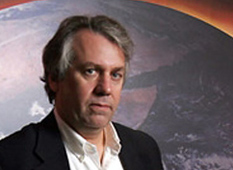Faculty Forum Online: Forging a New Direction in Climate Research, Feb. 5, 2013
-
-
slice.mit.edu
- 7
Filed Under
Recommended

Update: View a video of this presentation.
Research aimed at predicting future climate activity has primarily focused on large and complex numerical models. While this approach has provided some quantitative estimates of climate change, those predictions can vary greatly from one model to the next and produce doubts in the projected outcome.
In the next Faculty Forum Online broadcast, Professor Kerry Emanuel '76, PhD '78 will discuss a new approach to climate science that emphasizes basic understanding over black box simulation. After Emanuel presents a brief overview of climate research, he will take questions from the worldwide MIT community via video chat on Tuesday, Feb. 5, from noon to 12:30 p.m. (EST).
Register for this free event—Forging a New Direction in Climate Research—to receive the link for live viewing. After the event, return to Slice and continue the conversation in the comments.
About Kerry Emanuel '76, PhD '78
 Kerry Emanuel
Kerry Emanuel
In 2006, Emanuel was named by Time magazine as one of the 100 most influential people in the world. He is the author of What We Know about Climate Change, a book The New York Times called "the single best thing written about climate change for a general audience."
A Cecil and Ida Green Professor in the Department of Earth, Atmospheric and Planetary Sciences, Emanuel is a co-founder of the Lorenz Center, an MIT think tank devoted to understanding climate activity. His research focuses on tropical meteorology, hurricane physics, cumulus convection, and advanced methods of atmospheric sampling.
Emanuel received his bachelor's degree in earth, atmospheric, and planetary sciences from MIT in 1976 and his doctorate in meteorology from MIT in 1978.
RELATED
"The 2006 TIME 100: Kerry Emanuel," Time "An Antidote for Climate Contrarianism," The New York Times "Scientist proves conservatism and belief in climate change aren't incompatible," Los Angeles Times "Hybrid Hell: Hurricane Sandy is a kind of storm scientists don't understand well," Slate








Comments
Tom
Thu, 02/07/2013 10:06am
I agree. It seems to me that climate is inherently non-linear, ie chaotic, and that models will therefore be inherently unreliable. I dont think we know what caused the "little ice age" within historic times, much less the roughly 80,000 year cycle of pronounced temperature swings. This is a bit like modeling the economy, which is right when its right, which is about half the time.
gzuckier
Wed, 02/06/2013 9:35pm
http://geosci.uchicago.edu/~rtp1/papers/PhysTodayRT2011.pdf page 37. I'm not an expert on this, but as I understand it, the CO2 which absorbs the energy then reradiates it, some downwards, but some upwards. The CO2 above absorbs this reradiated heat, repeat. Basically, it's like adding additional layers of thin blankets.
Anyway, if the atmosphere were saturated with respect to absorbing all the IR, then we wouldn't be radiating any into space, and that's not true, IIRC.
Royce
Wed, 02/06/2013 8:55pm
I wish the professor had more time to talk about the areas of basic research that are needed in climate science. His discussion about stability points was interesting and I imagine there are very many more areas that are in need of basic research to understand this issue.
Correlation models can only get us so far, we need better understanding of mechanisms. Correlations based on past data provide a weak foundation for extrapolating into the future because new events often happen that make the correlations fall apart.
Jan Galkowski
Wed, 03/26/2014 8:20pm
@Tom,
I'm no climate scientist, but I am familiar with nonlinear system dynamics, and even if a system is dubbed in qualitative terms "nonlinear" or "chaotic" it is predictable. It's just that there are constraints on its predictability. Moreover, there are degrees of continuity and of smoothness. Just as it would be extraordinarily unusual for a summer day with temperatures at 90 degrees F to, within two hours, become minus 10 degress F, large systems like Earth and its currents and atmosphere don't (typically) discontinuously transition from one state to another abruptly when the states are widely removed. This means that even if there are nonlinearities, qualified predictions can be made.
I don't know about glacial cycles or the "little ice age", but it is a truly remarkable claim that says "We don't know what caused X means we don't know what causes anything". I believe, indeed, it has a name: falsum in uno, falsum in omnibus.
Dick
Thu, 02/07/2013 1:06pm
Thanks for pointing me to the best article on this issue I have seen. It appears that the answer to my question is yes, it is essentially broadening of the absorption bands that continues to reduce IR emission from the Earth as CO2 concentrations increase from their current level. My concern over climate effects of CO2 are correspondingly heightened. Get LED light bulbs, solar collectors, and push for replacing coal and oil with natural gas!
Dick
Tue, 02/05/2013 12:41pm
At many IR wavelengths CO2 makes the atmosphere opaque with current concentrations. Does increase CO2 concentration broaden the absorption wings enough that more CO2 leads to significantly more total IR absorption from the earth emission spectrum?
Nwadiuto Esiobu
Tue, 02/05/2013 1:34pm
Talks on intensifying agriculture to feed the earth's teaming population often evoke "climate-smart-agriculture" as the way out. Are reports that nitrogen fertilizers seem to impact the climate more than carbon emissions true? If so, how smart can we get around nitrogen challenge, outside precision dosing and biotech crops that use low N levels?